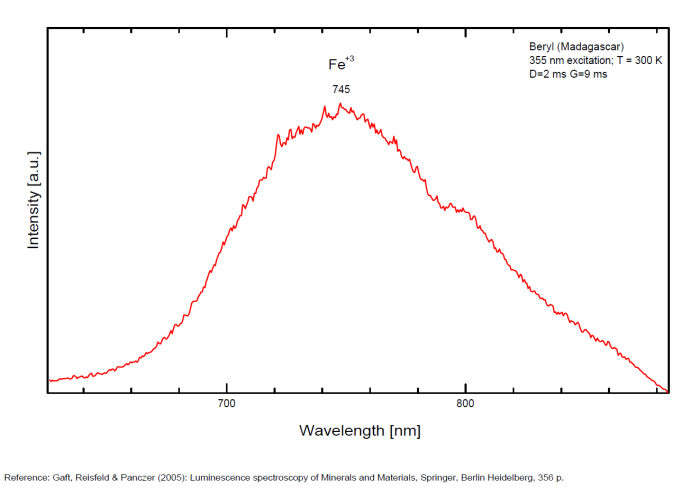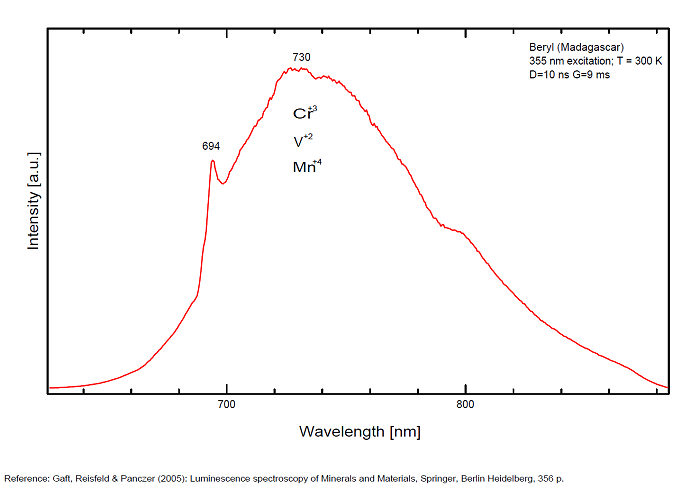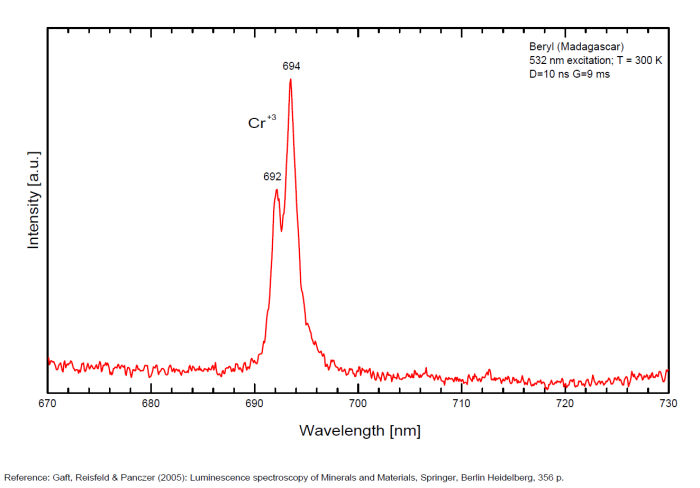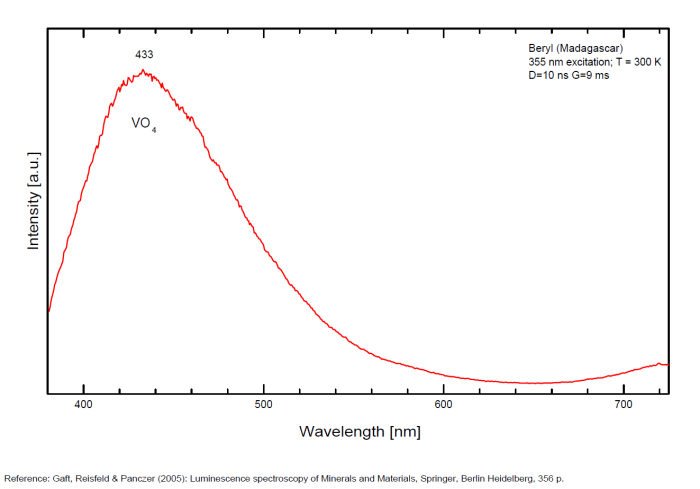Database of luminescent minerals
BERYL
Chemical formula: Be3Al2Si6O18
Family: Silicates
Status: IMA-GP
Crystal system : Hexagonal
Display mineral: NON
Associated names (luminescent varieties, discredited names, synonyms, etc.): aiguemarine, emeraude, morganite, goshenite,
Luminescence:
Longwave UV (365nm) colors: |
Orangy yellow , | ||
Shortwave UV (254nm) colors: |
Orangy yellow , Bluish White , Dark Orange /Tawn , Blue , Bluish , | ||
Do you have a photo of this mineral you would like to see in the gallery? Contact us!
Phosphorescence (in the common sense of the term) observable with the naked eye:
No phosphorescence visible to the naked eye under any type of UV
Activator(s) and spectrum:
Activator(s): Cr3+, Fe3+, Mn4+, V2+, VO43-,
Peaks in the spectrum (nm):
(VO4)3- : Broad band peaking at 433 nm Mn2+ tetrahedral : Broad band peaking at 480nm Mn2+ octaedral : Broad band peaking at 570nm Fe3+ or V2+ or Mn4+ : Broad band peaking at 720 - 745 nm (140nm half-width) Cr3+ or V2+ : Lines at 692 and 694nm

Spectrum: Michael Gaft, Petah Tikva, Israel. Plot: Institute of Mineralogy, University of Vienna, Austria, with permission of the authors.
Spectrum Galery:



 ...
...Comments on spectrum and activators:
Band peaking at 730 nm associated with Mn4+ (or Mn3+)
Broad band peaking at 480 (Mn2+ in tetrahedral) and 570 (Mn2+ in octaedral coordination).
Broad band peaking at 720 - 745 nm (Fe3+ or V2+ or Mn4+).
Lines at 692 and 694 (Cr3+).
Broad band peaking at 433 nm (VO4).
Best localities for fluorescence (*):
- Lavra Chia, Minas Gerais, Brazil;
- Pingwu beryl mine, Huya township, Mt Xuebaoding, Pingwu Co., Mianyang Prefecture, Sichuan Province, China (var. goshenite bluish-white SW);
- Weeks Quarry, East WakefieldNH, USA (faint peach color LW);
- Newry, Maine, USA (weak yellow LW, nothing SW)
- Gillette Quarry, Haddam Neck, Haddam, Middlesex Co., Connecticut, USA (var. morganite fluo blue-white SW);
- Strickland Quarry, Strickland pegmatite, Collins Hill, Portland, Middlesex Co., Connecticut, USA (blue SW);
- Tamminen Quarry, Greenwood, Oxford Co., Maine, USA (blue SW with fluorapatite yellow);
- Fillow Quarry, Branchville, Redding, Fairfield Co., Connecticut, USA (blue SW);
- Laghman Province, Afghanistan (var. morganite, blue SW);
- Konar Province, Afghanistan (var. morganite, blue SW);
- Mawi Pegmatite, Nilaw-Kolum Pegmatite Field, Du Ab District, Nuristan, Afghanistan (var morganite blue-white SW)
(*)The data are not exhaustive and are limited to a few remarkable localities for fluorescence
Bibliographic reference for luminescence:
- The Henkel Glossary of Fluorescent Minerals, Dr. Gerhard Henkel, Published by the FMS, 1989 ,
- Fluorescence: Gems and Minerals Under Ultraviolet Light, Manuel Robbins, 1994, Geoscience Press, ISBN 0-945005-13-X ,
- Luminescence Spectroscopy of Minerals and Materials, M. Gaft, R. Reisfeld, G. Panczer, Springer Editor, ISBN: 10 3-540-21918-8 ,
- Handbook of Fluorescent Gems and Minerals, a practical guide for the gem and mineral collector, Jack de Ment, 1949 ,
Reference for luminescence on the Internet:
Images:
- Gillette Quarry, Connecticut, USA (blue-white SW): http://www.mindat.org/photo-618479.html
- Strickland Quarry, Connecticut, USA (blue SW): http://www.mindat.org/photo-350719.html
- Tamminen Quarry, Maine, USA (blue SW): http://www.mindat.org/photo-350720.html
- Fillow Quarry, Connecticut, USA: http://www.mindat.org/photo-395962.html
- Mt Xuebaoding, Pingwu Co., China: http://www.mindat.org/photo-526048.html
- Mt Xuebaoding, Pingwu Co., China (var. goshenite): http://www.mindat.org/photo-530073.html
- Mt Xuebaoding, Pingwu Co., China (var. goshenite with fluorite & scheelite): http://www.mindat.org/photo-549299.html
- Laghman Province, Afghanistan (var. morganite): http://www.mindat.org/photo-662419.html
- Konar Province, Afghanistan (var. morganite, blue SW): http://www.mindat.org/photo-675578.html
- Various origins: https://www.mindat.org/photo-526048.html
Mineralogical reference on the Internet:
 http://www.mindat.org/show.php?name=Beryl
http://www.mindat.org/show.php?name=Beryl
 http://webmineral.com/data/Beryl.shtml
http://webmineral.com/data/Beryl.shtml
Internet Search:
 Image search on 'Google Images'
Image search on 'Google Images'
 Search for documents in all languages on Google
Search for documents in all languages on Google
A request providing no result means only that no such reference exists in the database, but it does not mean that what you are looking for does not exist, just not to our knowledge. If you think you have found an error or omission, please let us know via the contact page being sure to cite the source of information.

